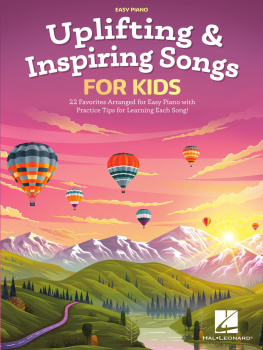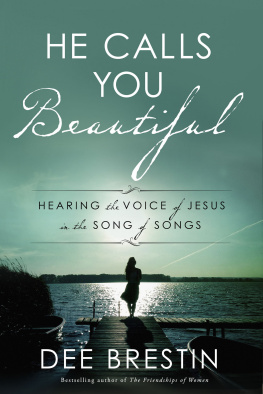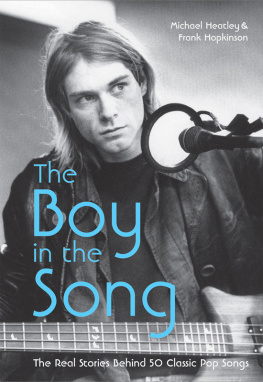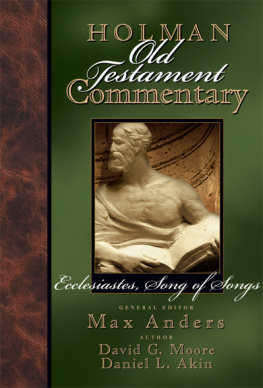2013 Jacki Breger. All rights reserved. Printed in the United States.
No part of this book may be reproduced, stored in a retrieval system, or transmitted, in any form or by any means, electronic, mechanical, photocopying, recording, or otherwise, without the prior permission of Healthy Learning. Throughout this book, the masculine shall be deemed to include the feminine and vice versa.
p. 14 and Chapter 8 epigraph: Pete Seeger, quote from the Introduction to Rise Up Singing,The Group Singing Songbook. 1988, 1992 Sing Out Corporation, Bethlehem, PA. Used by permission.
Chapter 1 epigraph: From The Songs Are Free, on Bill Moyers Journal, February 6, 1991. Used by permission of Bernice Johnson Reagon.
pp. 15-16 and p. 115: Marilyn Ward, The Extent To Which American Childrens Folk SongsAre Taught By General Music Teachers Throughout The United States, doctoral dissertation (University of Florida, 2003). Used by permission of Marilyn Ward.
p. 16: Excerpts from The Folk Songs of North America, by Alan Lomax (pages xxi and xv). New York. Doubleday & Company, Inc., 1960. Used by permission of the Alan Lomax Archive, 450 W. 41st Street, Room 606, New York, NY 10036.
p. 56: From The Applepickers Reel by Larry Hanks. 1967 Larry Hanks. All rights reserved.
p. 85: You Can Dance. Words and music by Lisa Atkinson. Copyright 1990 Lisa Atkinson. All rights reserved. Used by permission.
Definitions in Chapter 10: From The Random House Dictionary, Concise Edition. 1980, 1978 by Random House, Inc. Ballantine Books Edition: Tenth Printing: April 1989.
p. 111: Hands. Words and music by Cathy Fink. Copyright 1987 Cathy Fink, Leading Role Music, ASCAP. All rights reserved. Used by permission. From the CD Air Guitar. www.cathymarcy.com
p. 116: John Anthony Scott. The Ballad of America: The History of the United States in Song and Story. Carbondale: Southern Illinois University Press, 1983. Page 3.
Afterword Epigraph: Poem by Wendell Berry. Copyright 1984 by Wendell Berry. From Collected Poems: 1957-1982. Used by permission of Counterpoint.
DVD: My Ramblin Boy. Words and music by Tom Paxton. Copyright 1963 BMG Ruby Songs (ASCAP)/Dimensional Music of 1091 (ASCAP). Worldwide rights for BMG Ruby Songs administered by BMG Chrysalis. All rights reserved. Used by permission.
DVD: Ties That Bind. Words and music by Joan Boyd. Joan Boyd. Used by permission.
ISBN: 978-1-60679-144-8
Library of Congress Control Number: 2012947896
Cover design: Studio J Art & Design
Book layout: Studio J Art & Design
Cover photo: Leslie Wilson, taken at Tumbleweed Day Camp
Author photo: Hilary Kern, taken at CityLife
Healthy Learning
P.O. Box 1828
Monterey, CA 93942
www.healthylearning.com

Chapter 8: Oh, How Can We Harmonize?
Oh, How Can We Harmonize?
Tips for Singing Harmony and Part Songs
When three people discover a harmony they never
knew existed, or a crowd joins in on a chorus as
though to raise the ceiling a few feet higher, then
they also know: theres hope for the world.
Pete Seeger
Harmony is the most complex addition to songs and requires older kids and a few adults who can hold their parts. You have to be able to hear the parts for harmony to be successful. This doesnt mean you have to be a superb musician. You develop a musical ear by listening to many different kinds of music, and by singing all kinds of songs, including rounds.
Things to Think About Before Introducing Harmony
Know yourself
How is your musical ear?
Can you sing harmony?
Can you hear it when others sing it?
Are you comfortable with it?
What experience have you had singing harmony?
At camp
In your high school or college choir
Church choir
Youre a musical whiz
Know your group: staff
Which staff members are good harmony singers?
Who can be up front with you?
Who can help from within the group?
Know your group: kids
How have they done with rounds?
Are there enough older kids to sing melody and harmony?
Do they have prior experience singing harmony?
Know your songs
How many parts in a song?
Which songs in your repertoire need harmony?
Which have easy, medium, hard harmonies?
You know by now that I wont give you set rules for teaching harmonythere are just too many variables. I let harmony evolve when Im leading a group. I teach a song and we sing it often. Much as I love to sing harmony with kids, I have to force myself to be patient. If I introduce the harmony too soon, it will confuse them and well lose both the harmony and the melody. So I wait and watch for clues.
Im watching to see how many of the kids have mastered how many of the words. How much of the group knows all the words to the chorus? Even when returning kids and staff know a harmony, I hold them back; have them wait until Im sure that the new kids have securely learned the melody and words.
How many in the group know the words to the verses? Here not every child has to know every word, but I do need a majority to know all the words. I want a critical mass of singers who know a critical mass of words.
Im making judgments about whether or not they like the song. Did they ask for it? If I suggested it, did they go, ohhh yes, or did they moan and groan? Is the group agreed or is the group splitsome said yes and some said no. Of the kids who said no, are they the kids who say no to everything? Do they mean that they hate the song and never want to sing it, or that theyre just not in the mood for it today?
Im looking at affect. Do they seem relaxed or tense when singing the song? Do they watch me drift off into the song? Do they get silly with their friends? Are they singing to please me or because they are truly lost in the pleasure of the song?
Every time we sing, I look for clues. One day everything will feel just right. Ill see that the kids really know the song, that they like or love it, and that they experience great pleasure singing it. Thats the moment Ive been waiting for. Were ready to add a harmony part. Most likely, I will tell them how much progress theyve made, that it looks to me as if they know the song well. Ill ask if they agree and if they feel comfortable and strong singing it. Usually they will say yes. Then I tell them that theres a pretty harmony, another part that will make the song even prettier. If they sing the chorus, Ill sing the harmony.
In this clip the kids were singing so well through the first verse and chorus that I decided to add the harmony, unannounced, in the second chorus. I coached them to keep singing and I waited for the second line, just to be sure they were securely into the melody, and then I added the harmony. At first, I sang it softly, but as the song went on I began to sing it a little louder. (You can see the whole song in the Community Sing at the end of the DVD.) (DVD clip 8.1)
I watch them very closely. Older kids (11 and up) should be able to sing the melody. (You may have to stop and restart them once or twice.) Eight- to ten-year-olds will need help. Their tendency will be to drift into the harmony I am singing. Youve been saying all along that they should watch you, do what you doand now you are telling them not to watch you and to do something different from what you are doing. You might want to talk to them about how confusing you know this is, like you do when you begin to sing rounds. Having a co-leader is helpful hereyou can tell the kids which of you is singing the melody and who is singing the harmony. Tell them to watch the melody person.
Next page











![Othmar Keel - The Song of Songs [Song of Solomon]](/uploads/posts/book/82605/thumbs/othmar-keel-the-song-of-songs-song-of-solomon.jpg)

